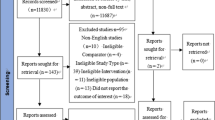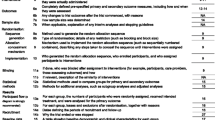Abstract
Context
Evidence suggests chronic physical activity (PA) participation may be both protective against the onset of and beneficial for reducing depressive symptoms.
Objective
The aim of this article is to assess the impact of PA interventions on depression in children and adolescents using meta-analysis.
Data sources
Published English language studies were located from manual and computerized searches of the following databases: PsycInfo, The Cochrane Database of Systematic Reviews and The Cochrane Central Register of Controlled Trials, Trials Register of Promoting Health Interventions (TRoPHI; EPPI Centre), Web of Science and MEDLINE.
Study selection
Studies meeting inclusion criteria (1) reported on interventions to promote or increase PA; (2) included children aged 5–11 years and/or adolescents aged 12–19 years; (3) reported on results using a quantitative measure of depression; (4) included a non-physical control or comparison group; and (5) were published in peer-reviewed journals written in English, up to and including May 2011 (when the search was conducted).
Data extraction
Studies were coded for methodological, participant and study characteristics. Comprehensive Meta-Analysis version-2 software was used to compute effect sizes, with subgroup analyses to identify moderating characteristics. Study quality was assessed using the Delphi technique.
Results
Nine studies were included (n = 581); most were school-based randomized controlled trials, randomized by individual. Studies used a variety of measurement tools to assess depressive symptoms. The summary treatment effect was small but significant (Hedges’ g = −0.26, standard error = 0.09, 95% confidence intervals = −0.43, −0.08, p = 0.004). Subgroup analyses showed that methodological (e.g. studies with both education and PA intervention; those with a higher quality score; and less than 3 months in duration) and participant characteristics (e.g. single-gender studies; those targeting overweight or obese groups) contributed most to the reduction in depression.
Conclusions
There was a small significant overall effect for PA on depression. More outcome-focused, high-quality trials are required to effectively inform the implementation of programmes to reduce depressive symptoms in children and adolescents.


Similar content being viewed by others
References
W.H.O. Atlas: child and adolescent mental health resources: global concerns, implications for the future. 2005; ISBN 92 4 156304 4.
Satcher DS. Executive summary: a report of the Surgeon General on mental health. Public Health Rep. 2000;115(1):89–101. PubMed PMID: 10968589. Pubmed Central PMCID: 1308561. Epub 2000/09/01. eng.
Neal DR. Treatment of depression in children and adolescents. Lancet. 2005;366(9489):933–40.
Guberman C, Manassis K. Symptomatology and family functioning in children and adolescents with comorbid anxiety and depression. J Can Acad Child Adolesc Psychiatry. 2011;20(3):186–95. PubMed PMID: 21804847. Pubmed Central PMCID: 3143694. Epub 2011/08/02. eng.
Lundy SM, Silva GE, Kaemingk KL, Goodwin JL, Quan SF. Cognitive functioning and academic performance in elementary school children with anxious/depressed and withdrawn symptoms. Open Pediatr Med J. 2010;4:1–9. PubMed PMID: 20664711. Pubmed Central PMCID: 2909621. Epub 2010/07/29. Eng.
W.H.O. The World Health Report. ISBN 92 4 156201 3; 2001.
Larun L, Nordheim Lena V, Ekeland E, Hagen Kåre B, Heian F. Exercise in prevention and treatment of anxiety and depression among children and young people. Cochrane Database Syst Rev [Internet]. 2006; (3). Available from: http://www.mrw.interscience.wiley.com/cochrane/clsysrev/articles/CD004691/frame.html.
Biddle SJH, Fox KR, Boutcher, SH. Physical activity and psychological well-being. London: Routledge; 2000.
Martinsen EW. Physical activity in the prevention and treatment of anxiety and depression. Nord J Psychiatry. 2008;62 Suppl 47:25–9. PubMed PMID: 18752115. Epub 2008/09/09. eng.
Fox KR. The influence of physical activity on mental well-being. Public Health Nutr. 1999;2(3A):411–8. PubMed PMID: 10610081. Epub 1999/12/28. eng.
Landers DM. The influence of exercise on mental health. Research Digest (President’s Council on Physical Fitness and Sports (US). 1997; Series 2 (no. 12).
Dunn AL, Trivedi MH, Kampert JB, Clark CG, Chambliss HO. Exercise treatment for depression: efficacy and dose response. Am J Prev Med. 2005;28(1):1–8.
Dunn AL, Trivedi MH, O’Neal HA. Physical activity dose-response effects on outcomes of depression and anxiety. Med Sci Sport Exerc. 2001;33(6):S587–97.
Strohle A. Physical activity, exercise, depression and anxiety disorders. J Neural Transm. 2009;116(6):777–84. PubMed PMID: ISI:000266926100017. English.
Biddle SJH, Asare M. Physical activity and mental health in children and adolescents: a review of reviews. Brit J Sport Med. 2011;45(11):886–95.
Calfas KJ. Effects of physical activity on psychological variables in adolescents. Pediatr Exerc Sci. 1994;6:406–23.
Verhagen AP, de Vet HC, de Bie RA, Kessels AG, Boers M, Bouter LM, et al. The Delphi list: a criteria list for quality assessment of randomized clinical trials for conducting systematic reviews developed by Delphi consensus. J Clin Epidemiol. 1998;51(12):1235–41. PubMed PMID: 10086815. Epub 1999/03/23. eng.
Borenstein M, Hedges L, Higgins J, Rothstein H. Comprehensive meta-analysis: a computer program for research synthesis. Englewood: Biostat; 2005.
Borenstein M, Hedges LV, Higgins JPT, Rothstein HR. A basic introduction to fixed and random effects models for meta-analysis. Res Synth Methods. 2010;1:97–111.
Field AP. Meta-analysis of correlation coefficients: a Monte Carlo comparison of fixed- and random-effects methods. Psychol Methods. 2001;6(2):161–80. PubMed PMID: 11411440. Epub 2001/06/20. eng.
Hedges LV, Olkin, I. Statistical methods for meta-analysis. New York: Academic Press; 1985.
Cohen J. Statistical power analysis for the behavioral sciences. 2nd ed. Hillsdale: Erlbaum; 1988.
Hedges LV. Distribution theory for Glass’s estimator of effect size and related estimators. J Educ Stat. 1981;6(2):107–28.
Brown SA, Upchurch SL, Acton GJ. A framework for developing a coding scheme for meta-analysis. Western J Nurs Res. 2003;25(2):205–22. PubMed PMID: 12666644. Epub 2003/04/02. eng.
Borenstein M. Introduction to meta-analysis. Chichester: Wiley; 2009.
Higgins JPT, Thompson SG, Deeks JJ, Altman DG. Measuring inconsistency in meta-analyses. BMJ. 2003;327(7414):557–60.
Rosenthal R. The file drawer problem and tolerance for null results. Psychol Bull. 1979;86(3):638–41.
Duval S, Tweedie R. A nonparametric “trim and fill” method of accounting for publication bias in meta-analysis. J Am Stat Assoc. 2000;95(449):89–98. PubMed PMID: ISI:000087845100013. English.
Duval S, Tweedie R. Trim and fill: a simple funnel-plot-based method of testing and adjusting for publication bias in meta-analysis. Biometrics. 2000;56(2):455–63. PubMed PMID: ISI:000087677500019. English.
Daley AJ, Copeland RJ, Wright NP, Roalfe A, Wales JKH. Exercise therapy as a treatment for psychopathologic conditions in obese and morbidly obese adolescents: A randomized, controlled trial. Pediatrics. 2006;118(5):2126–34. PubMed PMID: ISI:000241731700039. English.
Hilyer JC, Wilson DG, Dillon C, Caro L, Jenkins C, Spencer WA, et al. Physical-fitness training and counseling as treatment for youthful offenders. J Couns Psychol. 1982;29(3):292–303. PubMed PMID: ISI:A1982NP30500010. English.
Petty KH, Davis CL, Tkacz J, Young-Hyman D, Waller JL. Exercise effects on depressive symptoms and self-worth in overweight children: a randomized controlled trial. J Pediatr Psychol. 2009;34(9):929–39. PubMed PMID: 19223278. Pubmed Central PMCID: 2744328. Epub 2009/02/19. eng.
Melnyk BM, Jacobson D, Kelly S, O’Haver J, Small L, Mays MZ. Improving the mental health, healthy lifestyle choices, and physical health of hispanic adolescents: a randomized controlled pilot study. J School Health. 2009;79(12):575–84. PubMed PMID: ISI:000271711400002. English.
Mendelson T, Greenberg MT, Dariotis JK, Gould LF, Rhoades BL, Leaf PJ. Feasibility and preliminary outcomes of a school-based mindfulness intervention for urban youth. J Abnorm Child Psych. 2010;38(7):985–94. PubMed PMID: ISI:000282268900009. English.
Norris R, Carroll D, Cochrane R. The effects of physical activity and exercise training on psychological stress and well-being in an adolescent population. J Psychosom Res. 1992;36(1):55–65.
Bonhauser M, Fernandez G, Puschel K, Yanez F, Montero J, Thompson B, et al. Improving physical fitness and emotional well-being in adolescents of low socioeconomic status in Chile: results of a school-based controlled trial. Health Promot Int. 2005;20(2):113–22. PubMed PMID: 15788528. Epub 2005/03/25. eng.
MacMahon JR, Gross RT. Physical and psychological effects of aerobic exercise in delinquent adolescent males. Am J Dis Child. 1988;142(12):1361–6. PubMed PMID: 3195535. Epub 1988/12/01. eng.
Annesi JJ. Correlations of depression and total mood disturbance with physical activity and self-concept in preadolescents enrolled in an after-school exercise program. Psychol Rep. 2005;96(3 Pt 2):891–8. PubMed PMID: 16173355. Epub 2005/09/22. eng.
Goodman E, Whitaker RC. A prospective study of the role of depression in the development and persistence of adolescent obesity. Pediatrics. 2002;110(3):497–504.
Lumeng JC, Gannon K, Cabral HJ, Frank DA, Zuckerman B. Association between clinically meaningful behavior problems and overweight in children. Pediatrics. 2003;112(5):1138–45.
Strong WB, Malina RM, Blimkie CJ, Daniels SR, Dishman RK, Gutin B, et al. Evidence based physical activity for school-age youth. J Pediatr. 2005;146(6):732–7. PubMed PMID: 15973308. Epub 2005/06/24. eng.
Washington RL. Does increasing physical activity really make a difference? Show me the evidence. Pediatrics. 2005;146(6):A2.
Fox KR. The effects of exercise on self-perceptions and self-esteem. In: Biddle SJH, editor. Physical activity and psychological well-being. London: Routledge; 2000. p. 88–117.
Acknowledgements
Funding sources: This work was supported by an Alf Howard International Travel Scholarship (School of Human Movement Studies, University of Queensland) that enabled international collaborative work to be undertaken. Helen Elizabeth Brown was partially supported by an Australian NHMRC Program Grant (# 301110). The authors have no conflicts of interest that are directly relevant to the content of this review.
Author information
Authors and Affiliations
Corresponding author
Rights and permissions
About this article
Cite this article
Brown, H.E., Pearson, N., Braithwaite, R.E. et al. Physical Activity Interventions and Depression in Children and Adolescents. Sports Med 43, 195–206 (2013). https://doi.org/10.1007/s40279-012-0015-8
Published:
Issue Date:
DOI: https://doi.org/10.1007/s40279-012-0015-8




